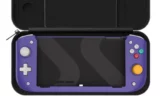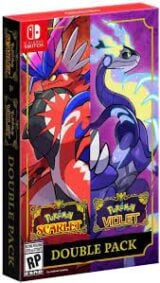BitSummit day one: J-Hip-Hop swordfests and a Seoul-crushing platformer
The first in our series of impressions on new and upcoming indie games

This year’s BitSummit is now underway, with the first day recently ending in Japan.
BitSummit is Japan’s leading independent games expo, featuring a whole host of new and upcoming indie games from all over the world.
This year’s event, BitSummit Drift, takes place at its usual venue of the Miyako Messe in Kyoto, and I’m here covering it for all three days.
More than 100 games are available to play this year, and while it’s not possible to play them all, I’m making it my mission to get through as many as I can and deliver hands-on impressions.
Some of these games may not be too familiar to you now, but – as was the case last year – most of them will eventually get a western release and will see more coverage in the future.
Consider this article, then, a look at some of the indie games people will be talking about later this year and next, and some of the more interesting recently released titles you may have missed.
Sonokuni
This was the first game I played on the day and it certainly woke me up.
The game is developed by Don Yasa Crew, a Japanese hip-hop group dipping its toes in game development for the first time.
I spoke to Don Sagawa, the leader of the crew, who told me that Hotline Miami was a big inspiration, and the game that made him want to get into game development in the first place.
The inspiration is clear, because the game is played from a top-down perspective and has similar visuals to Hotline Miami, but it’s certainly its own beast too.
The player can die with one hit but they’re armed with the ability to slow down time, block blue projectiles and use their sword to knock back red projectiles.
Each of the enemy types is handled in a different way, and if one kills you, you can wait for a second and you’ll be shown a quick diagram explaining which strategies do and don’t work.
The challenge comes in the way each small room is crammed with a variety of these enemies meaning you have to constantly be aware of everyone and plan out which order to defeat them.
You will die a lot, but that’s the point of the game, and every time you do you respond almost instantly at the start of the last room, meaning you can fire out a bunch of different strategies until you find the one that works.
When all comes together each room feels like its own action movie, with you putting together expertly choreographed sequences of dodges, blocks, deflections and time slowing trickery. It makes you feel cool as hell.
Naturally, given who’s behind it, The soundtrack is outstanding. I asked Don Sagawa if it was going to get its own standalone release because I would happily listen to it. He said it was something he hoped to do. For now though, I’m more keen to get my hands on the full game.
Holo X Break
Hololive is a VTuber agency which manages over 90 virtual YouTuber personas.
It also has its own indie game publishing label, Holo Indies, of which nine of its games are available to play at BitSummit.
I opted for Holo X Break, a simple but fun enough beat ‘em up in the style of Final Fight and the like.
Players choose from a selection of Hololive VTubers, each with their own special abilities, and fight through each level, rescuing companion characters who then fight alongside them.
It’s certainly nothing life-changing, but I had a fun enough time with it anyway, and given that it’s already on Steam and is completely free, you might as well give it a go.
Oh, and the X in the title is apparently silent, because why not.
The Spirit of the Samurai
This is a visually stunning side scrolling action game, in which you play as a samurai and eventually a kodama (spirit) and a cat.
The section we played opened with a brief stage where the samurai fights numerous other sword-wielding enemies in a densely foggy environment.
It then moved onto a bigger stage set inside and around a large house, which has been infested by giant bug-like creatures and undead swordsmen.
The aim here is to find one of the survivors in the basement and help them prepare to leave safely.
The game is based on stop-motion animation, so while the screen scrolls smoothly the character motions are deliberately less fluid, making for a unique effect while playing.
Unfortunately, when we met the survivor, she sent us out to find an object for her, and given the short playtime we weren’t actually able to find the item.
This, combined with the slightly clunky controls (which may be deliberate to increase difficulty), made for a game that I didn’t click with right away, but still left me eager to try more by the time the session had ended.
Voidwrought
Developed by Swedish studio Powersnake, Voidwrought is a Metroidvania that may not win all the prizes for originality, but plays solidly regardless.
The protagonist starts with a basic slash attack and fights skeletons and other gruesome creatures, giving a vibe similar to the GBA and DS Castlevania games (or, day I say it, Silksong).
By the time the demo had ended I had acquired two more skills – the ability to charge attacks and break purple barriers as a result, and the ability to fire out a tendril which attaches to grapple points.
Nothing here is remarkably unique, but what was on offer was still satisfying to play and I’m curious to see which powers get added later on in the game.
The music is also absolutely tremendous, getting particularly epic and grandiose during the tense boss fights we played.
The demo for Voidwrought is available on Steam now, so don’t just take my word for it, try it out.
Arranger: A Role-Puzzling Adventure
Nintendo returns to BitSummit this year with its Indie World booth, where guests can queue up to get 15 minutes playing a new or upcoming Switch indie game of their choice, and be gifted with a towel with ‘Indie World’ written on hiragana when they leave.
There’s no way I was going all the way to Kyoto and not leaving with some Nintendo tat, so I opted for Arranger, which is out next week. If you aren’t familiar with it, it’s an interesting adventure game where the entire world is set on sliding rows and columns.
The opening section teaches you the mechanics via a variety of puzzles, the first series of which involve moving around swords by sliding the grid around. By moving a sword into an enemy they’ll die and clear a path.
Things get more complicated when large stone feet are added to the equation: these block swords, so you have to figure out how to slide the stage around to navigate the sword past the feet and reach the enemy.
After this section you get to explore the world a bit more and speak to some of the NPCs, who have different sliding-related tasks for you to do.
Unfortunately, because this demo was only in Japanese, making these missions impenetrable, this is where my time with Arranger ended. I liked what I played but it has the potential to be one of those games that gives you a massive headache before too long.
Regardless, you’d better believe I spent the last five minutes just wandering around until my time ran out so I could claim one of those towels.
Rushing Beat X: Return of Brawl Brothers
The Rushing Beat games were a trilogy of 16-bit beat ‘em ups released by Jaleco in the ‘90s, known in the west as Rival Turf, Brawl Brothers and The Peace Keepers.
Rushing Beat X brings the series back after a 30-year absence, with a brand new fourth game.
Rather than sticking with sprite-based pixel art for this fourth game, Rushing Beat X switches to polygonal graphics, using a cel-shaded effect to give it a comic book style.
As far as beat ‘em ups go this felt solid enough, and the four characters who were available in the demo all felt different enough to justify multiple playthroughs of the full game (though M Bison lookalike Douglas Bild, who used to be known as Oozie Nelson in the west, is clearly the best).
As a sucker for a retro revival I’m just happy to see this game exist, and the fact it’s shaping up to be a fun enough beat ‘em up is a relief.
Until then, all three games in the original trilogy are available in the SNES library on Nintendo Switch online, so you’ve got plenty of time to brush up on the series before this fourth game is out.
Hordes of Hunger
Hordes of Hunger is the latest game from Polish studio Hyperstrange, which previously worked on wild west FPS Blood West.
You play as Mirah, who has to defend her homeland from a constantly oncoming horde of monsters. The game’s a third-person rouge-lite arena slasher where you’re given a series of missions and have to survive as long as you can.
I was able to play through two missions before my session ended. The first was straightforward – kill 100 enemies without dying. There are health potions located around the stage but they aren’t highlighted until you’re close to death, meaning you can’t easily run around storing them all up at the start of the mission.
The second mission was a defence task, where Mirah has to stand around someone trapped in a set of stocks, and defeat enemies until they’re eventually freed. Cue more hacking and slashing.
Naturally, this being a rogue-lite, the idea is that you’ll keep dying, returning to the hub, buying upgrades to make you progressively stronger and tinkering with your ever-varied loadout until you find the setup that finally gets you through to the end of the game. Which was a bit of an ask for a 20-minute demo, to be fair.
This was a fun time, I’m curious to see how it continues to keep the player’s interest 10 hours or so down the road.
Umamusume Pretty Derby: Party Dash
Umamusume Pretty Derby is a manga, anime and video game franchise about a world where famous race horses are reincarnated as ‘horse girls’, which are basically idol girls with big ears and a tail. Look, I’ve got neigh idea.
Party Dash is a multi-event party game. I first played it at BitSummit last year, where only one of its events was available – Hurtling Hurdles, a brilliantly barmy four-player race through city streets.
This time developer Cygames is back with another event, Dodgeball Demolition, which is a four-player dodgeball game where the aim is obviously to take out your opponents.
A couple of balls roll around the arena and you have to grab them and chuck them at the other players. You can either tap the button to throw normally, or charge your throw for a more powerful one.
As is the dodgeball way, you can either get out of the way when a ball is thrown at you, or try to hit the button at just the right time to catch it, powering up your return shot.
You can also charge up a super power by holding down a shoulder button. This is very risky because it can take a long time and you can’t move while you do it, so you have to hope the other players get busy fighting with each other. If you pull it off, though, you can perform a screen-filling blast.
It’s a fun enough mode but the race event I played last year was much better. The full game, containing both modes plus Gourmet Gauntlet and Blazing Baskets, will be released on August 30 worldwide.
Goodbye Seoul
It’s something of a nice bookend that the first and last games I played on day 1 of BitSummit are the two I enjoyed the most.
Goodbye Seoul is a pre-apocalyptic game set in South Korea’s capital city, and follows a young woman called Rion as she wanders around a Seoul that has been ransacked and ravaged from pillar to post.
The world is set to be hit by an asteroid in six months, and the people of Seoul have caused carnage as a result, turning the city into a complete wasteland.
Rion, who was already on a low ebb before this happens, decides to cut to the chase and heads to a bridge to take her own life, but before she does she finds herself tasked with a delivery that could result in the safe evacuation of some of humankind, including herself.
You only need to watch the trailer above to see why Goodbye Seoul is so special. From the pseudo-pixel artwork to the wonderful music to the incredible art design, I fell in love with this one a bit.
The gameplay is the sort of physics-based 2.5D puzzle platformer stuff you may have seen before in the likes of Limbo and Somerville, and none of it was particularly taxing (though obviously I only played the first 20 minutes or so), but the atmosphere makes up a large part of the experience here.
That’s all for our day one coverage from BitSummit.
We’ll have more hands-on impressions after day two and day three, along with a longer article on our Game of the Show once it’s all wrapped up.















